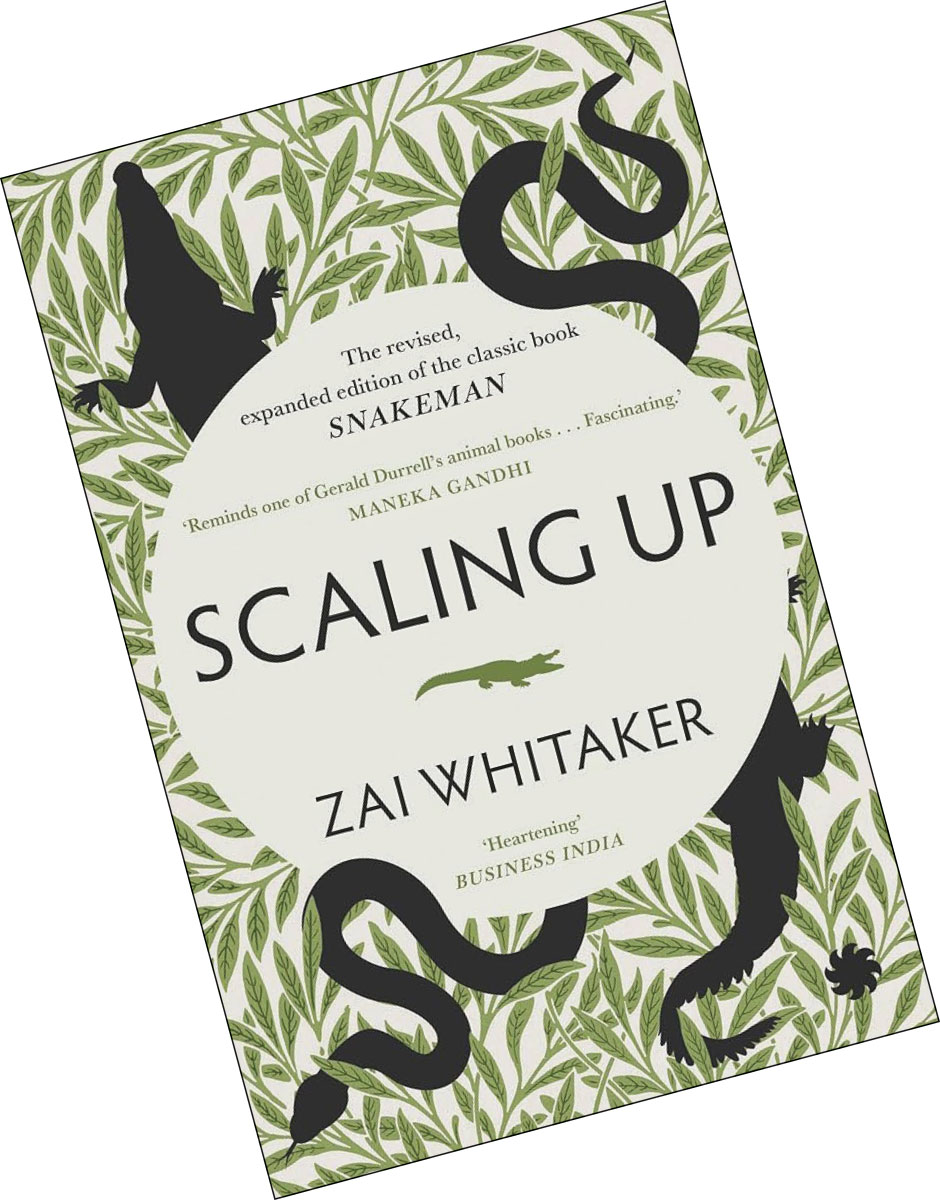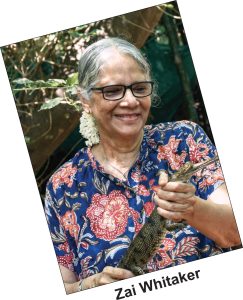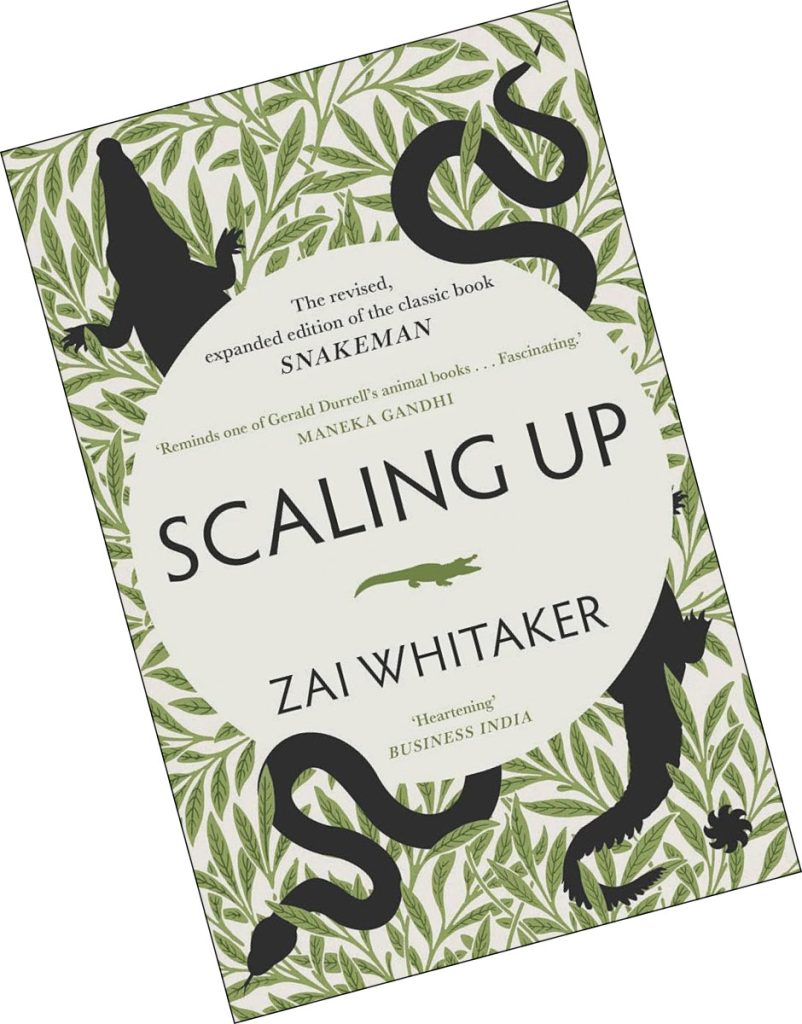

We are all familiar with shows that follow seemingly fearless individuals dig unceremoniously into the private lives, so to speak, of animals deemed to be dangerous: a resting python, a nesting crocodile, and the like. They make me wonder how those creatures, most often minding their own business, might feel. The title of this month’s column is borrowed from a folktale about a snake that wishes only to be regarded with love and consequently ends up being bullied and brutalised by humans. It is saved by wise counsel from a wandering monk who give it the mantra contained in the title.
Scaling Up, by Zai Whitaker, recounts many instances of the interaction between humans and reptiles in the course of telling the amazing story of Romulus Whitaker, the paambukaaran (snakeman). The book, which is a revised and expanded version of Snakeman (published in 1989), was recently launched in Chennai in the presence of a large and enthralled audience. The new title was inspired by a conversation. In Zai’s words: ‘The title of the book comes from a conversation with Salim Mamoo, who visited me in Madras soon after I got married and asked how I was getting on. I gave him a pompous reply about how satisfying it was to work for this neglected group of animals. “Birds and mammals get all the attention,” said I, “but reptiles are equally important…” He looked a bit taken aback, did his famous head-bobbing, and said, “Oh, so you’re SCALING them up, are you?” ’
Yes, Salim Mamoo is that Salim, Salim Ali, the birdman of India! Zai’s mother Laeeq’s uncle. Her father Zafar’s grandfather was the well-known freedom fighter Badruddin Tyabji. Laeeq was a writer with a keen interest in plants and gardening; she was the literary editor of Quest magazine for many years. Zafar was a naturalist and conservationist, with a keen interest in birds, and for 45 years, edited the Newsletter for Birdwatchers which consistently nourished the appetites of birders and birdwatchers all over India; he started the India chapter of the WWF.
Reading what Zai quotes from Laeeq’s book, Gardening, — ‘Perhaps it was an advantage that we had a house before we had an income, for the need to organise the land without any money was good training’ — you understand that gentle humour runs in Zai’s DNA. Scaling Up is written with wit and affection, so much so that reading about reptiles was probably never so much fun, even for those who get goosebumps at the mention of snakes! Given her family tree and being married to Rom for several years put Zai in the ideal position to not only have wonderful, new experiences in the world of nature, but also to observe closely the beginnings of reptile studies in India. And with her remarkable writing skills, Zai has been able to communicate imaginatively to a massive audience, comprising children and adults.

Quite apart from the fact that their work brought Rom and Zai close to the Irulars, a snake-catching community in Tamil Nadu, their emotional attachment to these people is palpable through their association via several platforms. One of them is the Irular Snake Catchers’ Industrial Cooperative Society (ISCICS) which supplies snakes for the production of antivenom. Zai is also deeply invested in the Irular Women’s Society that has been working for women’s economic and social empowerment. Zai unselfconsciously weaves in the personal into this narrative about the phenomenal work done by Rom with snakes and crocodiles, which led to the setting up, first of the Snake Park in Chennai (then Madras) and later, the Crocodile Bank just outside Chennai. We follow Zai’s journey through the ghats and the Andaman and Nicobar Islands, Papua New Guinea, the Snake Park, the Croc Bank, the Kodai International School and other places she taught at… to the present time when she is managing trustee of the Madras Crocodile Bank Trust and Centre for Herpetology. While Scaling Up focuses on the seminal work of Romulus Whitaker, it acknowledges many others engaged in conservation and wildlife work, both nationally and internationally. It also recognises the work done by several individuals who started off volunteering at the Croc Bank and who have now become central to wildlife conservation.

It’s not all rosy, and Zai says as much. In the end, though, it’s an inspiring story set against great odds. Take the case of snakebite alone. ‘India tops the list,’ she writes, ‘with 50,000 or more deaths a year and at least triple that number of morbidities like the loss of a limb, kidney failure or PTSD following snakebite. The majority of victims are poor farmers or farm labourers, often the sole earning members of the family.’ Which makes the work of the Irular all the more valuable: ‘We loved the idea that the Irular, one of the poorest of our Adivasi groups, should produce one of the most pricey products in the country. At that time, a gram of krait venom cost three thousand rupees, ten times the price of gold. About fifty kraits are needed to make one gram.’
I was a teenager when we went on a family outing to Selaiyur, Tambaram, in the early 1970s, where a snake park had just opened. A blonde, long- haired man was sitting inside a large pit nursing a baby crocodile in one hand. He said the baby croc had bitten him and he was trying to make friends with it. When my aunt headed towards the snakes, I followed. ‘Would you like to hold it?’ a young man asked, holding out a huge python. ‘It’s just eaten, so it’s sleepy.’ As it wrapped itself around my hand, I was surprised by how smooth and dry its underside felt. There were many young people working there, I remember. Maybe Zai was one of them?

The book highlights many aspects of human-animal conflict that should make us reflect on what we are doing to Earth. Zai recalls that she and her sister Shama were drawn to birds, particularly the raggiana, ‘one among the forty or so species of birds of paradise’. She goes on to write: ‘When flamboyant bird feathers became fashionable adornments on ladies’ hats in nineteenth-century Europe, and milliners began importing birds of paradise from parts of Indonesia, New Guinea and Australia, the bird skins were exported after chopping off the legs. The glitterati, fashionable but ignorant, believed that these were legless birds that had descended from heaven/paradise.’
But it’s not all doom and gloom. The work of the Croc Bank is a case in point, as also the amazing insight emanating from the study of reptiles. American turtle expert Mike Ewert explains that the reason why ‘Indian flapshell turtle eggs develop almost full-term embryos, then sit and wait for six months before hatching’ is because they need ponds and streams to live in. Therefore, they hatch when they are stimulated by the sound of rain. ‘If they hatched in the hostile hot season, they probably wouldn’t survive for more than two days,’ writes Zai.
This is an important book, both for the world of wildlife and the world of literature. The writing is deft, light, detailed, and always laced with gentle humour. For instance, at the end of the formal conversation during the launch, Zai was asked which creatures frightened her. She responded that if she had to name them, it would be the human kind.
The columnist is a children’s writer and senior journalist






